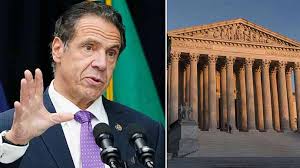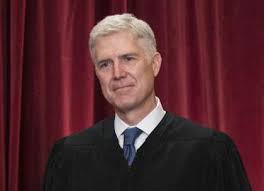|
On November 25, 2020, in a 5-4 ruling, the U.S. Supreme Court sided with religious organizations in a case over COVID-19 restrictions put in place by New York Governor Andrew Cuomo. The recent appointment of Justice Amy Coney Barrett has given the court a conservative majority, so the ruling should not be surprising. Is this ruling a shadow of things to come for the high court or just a one-off event? Let’s take a closer look. I am not a lawyer. The extent of my legal training is a few graduate level courses in business and tax law. When I am confronted with a constitutional issue that I am not familiar with I first consult the relevant articles in the U.S. Constitution. Then I attempt to determine the intention of the writers of the Constitution by reviewing the Federalist Papers, and any other pertinent writings. Finally, I see if there have been any similar cases ruled on by the Supreme Court which may have established a precedent for the issue under review. Fortunately, I have already researched and addressed the constitutionality of pandemic restrictions in my previous blog "are-pandemic-restrictions-violating-your-first-amendment-rights.html". From the previous blog on this topic we know that states have broad powers to restrict individual liberties in the name of public health. In issues of medical and scientific uncertainties, state health officials should not be subject to second-guessing by an unelected federal judiciary which lacks the background, competence, and expertise to assess public health matters. Restraints may be placed on constitutional rights by the state for the common good. However, the restrictions have to be applied without preference to content or viewpoint. For example, if officials restrict indoor religious gatherings to 50 people, they must restrict all indoor gatherings to 50 people. This is where I think the State of New York crossed over the line. The state singled out houses of worship and imposed harsh restrictions on indoor religious gatherings. Let’s take a look at the case. Roman Catholic Diocese of Brooklyn, New York v. Andrew M. Cuomo, Governor of New York : www.supremecourt.gov/opinions/20pdf/20a87_4g15.pdf The Catholic Diocese of Brooklyn, along with Agudath Israel of America sought to overturn an Executive Order issued by Governor Cuomo which imposed restrictions on attendance at indoor religious services taking place in “red” or “orange” zones. In red zones, no more than ten people could attend each religious service, and in orange zones, attendance was limited to twenty-five. The religious groups claimed that this was in violation of the Free Exercise (of religion) Clause of the First Amendment. They argued that the regulations treated houses of worship much more harshly than comparable secular facilities. Five of the nine justices agreed, writing that “…the regulations cannot be viewed as neutral because they single out houses of worship for especially harsh treatment”. As an example, in an orange zone attendance at houses of worship is limited to twenty-five people, even though non-essential businesses may decide for themselves how many people to admit. It should be noted that before this case was decided, Governor Cuomo reclassified the areas in question from orange to yellow, allowing for religious services to take place at 50% of their maximum capacity. However, the Court went forward with the case because the Governor could enact more restrictive classifications at any time. Implications of the Ruling: The case’s immediate impact is narrow, setting aside two specific restrictions on attendance at houses of worship in New York. The ruling did not overturn all pandemic restrictions at houses of worship, such as mask wearing and social distancing mandates. I don’t think that this case sheds any additional light on how Justice Amy Coney Barrett will rule in future cases. She did vote with the conservative majority, but did not issue her own opinion. The most telling opinion was written by Trump appointee Neil Gorsuch. He wrote, “Government is not free to disregard the First Amendment in times of crisis”. He went on to write that the court precedent that Chief Justice Roberts cited in a related California case, “…hardly supports cutting the Constitution loose during a pandemic”. You may read the full text of the case and accompanying opinions at the link cited above. Earlier in the year the Supreme Court upheld indoor religious service restrictions in California and Nevada: (https://www.supremecourt.gov/opinions/19pdf/19a1044_pok0.pdf). These restrictions were not as severe as the ones in New York, and applied equally to religious and secular organizations. The new conservative court may have a different view. The New York case will certainly embolden religious groups, and we will soon see challenges to California’s restrictions on indoor religious gatherings. Just this Thursday the AP reported that the Supreme Court ordered a lower federal court to reexamine California restrictions on indoor religious services in light of the recent ruling in New York. With COVID-19 cases surging in California, it is uncertain if the Governor’s restrictions will stand. What does seem certain is that Chief Justice Roberts will have a challenging time holding sway over the five conservative justices, and his position as the swing voter on the Court has been neutered. I agree with the Supreme Court’s ruling overturning New York’s attendance restrictions on religious gatherings. These restrictions specifically targeted houses of worship in violation of their First Amendment rights. New York classified such businesses as liquor stores, bicycle repair shops, hardware stores, and acupuncturists as “essential”, and therefore not subject to capacity restrictions. This seems arbitrary. Does it make any kind of sense to restrict a 1000 seat church to ten or even twenty-five attendees when it is legal to cram 200 people into the passenger cabin of a jetliner for a six-hour transcontinental flight? Not to get sidetracked, but most airline travel today is nonessential, and a passenger may take off their mask to eat or drink. Sounds like an indoor restaurant to me, but restaurants are no longer allowed to offer indoor dining. My point is, that it is a slippery slope when we allow public officials to pick winners and losers. When that happens, we have a lot more to lose than just our religious freedoms. As for the new conservative court, governors have been warned that they better carefully consider any restrictions that interfere with the free exercise of religion, even during a pandemic. February 23, 2021 Update: On February 5, 2021 the Supreme Court ruled that California’s ban on indoor church services violated the free exercise of religion guaranteed by the First Amendment. But the Court kept in place prohibitions on singing and chanting, and allowed the state to limit indoor services to 25% of the building’s capacity. This is not surprising in light of a similar ruling in New York last November.
The decision was 6-3, with the majority arguing that California had singled out places of worship for unfair treatment. This is hard to argue against since some religious buildings are the size of whole city blocks, and restricting any attendance in such buildings seems arbitrary and not grounded in science. The Court’s three liberal decenters stuck to the belief that the Court should not overrule the public health experts during an ongoing pandemic. If you enjoy reading this type of commentary please subscribe to my blog and tell a friend. You will receive an email notification when new blogs are posted. The email will come from the site’s email: armchairamerican1776 American @gmail.com. Thanks, Armchair American
0 Comments
Leave a Reply. |
AuthorThe Armchair American. Archives
November 2024
Categories
All
|









 RSS Feed
RSS Feed